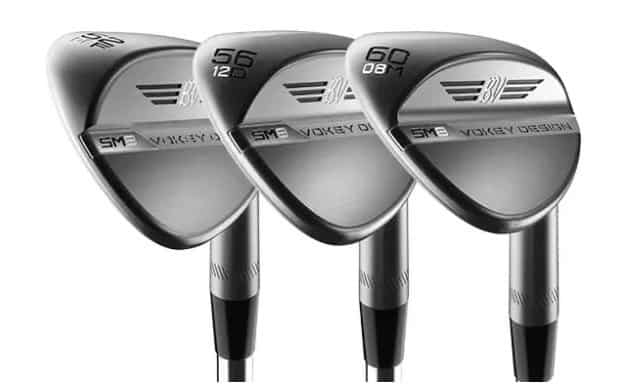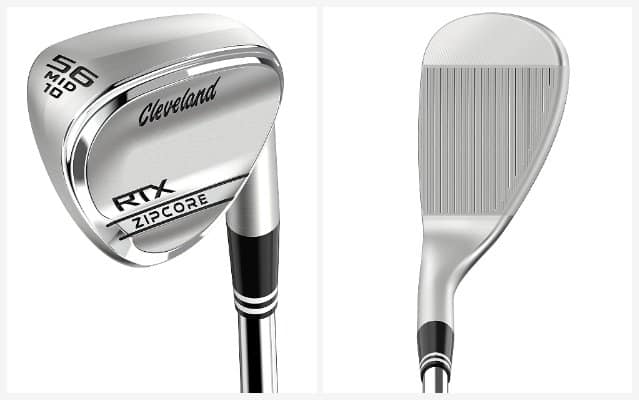When it comes to choosing a sand wedge, one of the biggest decisions to make is whether to buy one with 54 or 56 degrees of loft.
This choice can often present a tricky dilemma for the average golfer.
They ask themselves: What’s the difference? Both clubs look the same, does it really matter which one I get?
The variances between a 54 degree wedge and 56 degree wedge are minor – only two degrees, to be precise – yet they are important.
So, which wedge should you choose? The answer: it depends on what loft your gap wedge is.
If you have a gap wedge with 50 degrees of loft, you’re better to use a 54 degree sand wedge. If your gap wedge has 52 degrees of loft, then a 56 degree sand wedge will be a better choice. This will ensure you have the correct gapping between your wedges.
In this article, I’m going to explain the importance of gapping and why it has a huge influence on whether you buy a 54 or 56 degree wedge.
I’ll also elaborate on the correct bounce your sand wedge should have (either 10, 12 or 14 degrees), depending on the quality of bunkers at your regular course.
By the end of this article, you should have a clear understanding of whether a 54 or 56 degree wedge is the right one for you.
Table of contents
Is it better to use a 54 or 56 degree wedge?
Whether to use a 54 or 56 degree wedge will be determined by the loft of your gap wedge. If your gap wedge has 50 degrees of loft, then it’s best to use a 54 degree wedge as your sand wedge. If your gap wedge has 52 degrees of loft, then you should use a 56 degree wedge as your sand wedge.
Deciding on whether to use a sand wedge with 54 or 56 degrees of loft, ultimately, comes down to your gapping requirements.
Usually, the loft on each golf club will increase by four degrees each time – for example, if you have a pitching wedge with 46 degrees of loft, then typically you would use a 50 degree gap wedge, a 54 degree sand wedge, and so on.
This, for most players, will ensure the gaps between your clubs stays consistent and doesn’t leave you needing to find an extra 10 yards in your swing in order fill those distances.
In this scenario, a typical wedge set-up might look like this:
- Pitching wedge: 46 degrees of loft (125 yards)
- Gap wedge: 50 degrees of loft (110 yards)
- Sand wedge: 54 degree of loft (95 yards)
- Lob wedge: 58 degrees of loft (80 yards)
Another suitable set-up might be similar, but slightly different:
- Pitching wedge: 48 degrees of loft (120 yards)
- Gap wedge: 52 degrees of loft (105 yards)
- Sand wedge: 56 degrees of loft (90 yards)
- Lob wedge: 60 degrees of loft (75 yards)

As you can see, both of these wedge configurations have consistent gapping of 15 yards between clubs – regardless of whether the player has a 54 or 56 degree sand wedge in their bag.
What you should never see is gapping as followed:
- Pitching wedge: 46 degrees (125 yards)
- Gap wedge: 50 degrees (110 yards)
- Sand wedge: 56 degrees (90 yards)
- Lob wedge: 64 degrees (65 yards)
In this scenario, the golfer, simply by choosing the incorrect lofts for their sand and lob wedges, has left him or her self with far too greater gaps between their clubs – meaning they’re going to have to either swing out of their shoes, or dial right back in order to hit their desired yardages.
This makes it difficult to become a consistent wedge player.
Instead, pick the correct loft from the outset – either 54 or 56 degrees for your sand wedge, depending on what your gap and lob wedges are – and you’ll find it far easier to develop distance control from inside 110 yards.
If you struggle with your wedge play, I’d recommend you check out some of our other articles below:
- Stop It Dead: How To Put Backspin On Your Wedges In Golf
- 4 Best Golf Chipping Techniques (And How To Master Them)
- How To Chip Consistently In Golf (Decide To Go High Or Low)
- Chipping vs Pitching In Golf: The Key Differences Explained
What is a 54 degree wedge used for?
A 54 degree wedge is typically used as a sand wedge and sits between your gap wedge and lob wedge. Usually, golfers will add a 54 degree wedge to their bag if their gap wedge has 50 degrees of loft, and their lob wedge has 58 degrees of loft.
The 54 degree wedge is a versatile club as it can be used from the fairway for full swings inside 100 yards; for bump and run chip shots, or high-flighted pitches around the green that require extra elevation; and for shots out of greenside bunkers.
Higher-handicap players will usually stick to using their 54 degree wedge for full swings, while lower handicap players – due to their better skill and touch – often use it for chipping, as the extra loft allows them to impart greater backspin onto their ball, and get it to stop quickly on their intended landing zone.
If you can become deadly accurate with your 54 degree wedge around the greens, or out of bunkers, it will dramatically improve your scoring by helping you get up-and-down more regularly.
You’ll say goodbye to those scores over 90 or 100 in no time.
What is a 56 degree wedge used for?
A 56 degree wedge is typically used as a sand wedge and sits between your gap wedge and lob wedge. Usually, golfers will add a 56 degree wedge to their bag if their gap wedge has 52 degrees of loft, and their lob wedge has 60 degrees of loft.
Naturally, the 56 degree wedge is used in the same way as the 54 degree wedge: for full swings inside 100 yards; for chip and pitch shots; and for escaping greenside bunkers.
Like the 54 degree wedge, the 56 degree wedge occupies the role of ‘sand wedge’ in your bag.
The only difference will be the clubs that sit either side of it (usually 50/58 for a 54 degree sand wedge, or 52/60 for a 56 degree sand wedge, as explained earlier).
How far should you hit a 54 degree wedge?
The average male golfer will hit their 54 degree wedge anywhere between 80-100 yards (73-91 metres), while female players will range between 55-75 yards (50-68 metres). Professional male players average around 115 yards (105 metres) with a 54 degree wedge, and female players 85 yards (77 metres).
These numbers are based off the Trackman data I analysed in another article, where I calculated the carry distances for 50 and 52 degree wedges when used by average male and female players versus professional male and female players.
Now, while we can all squeeze an extra few yards out of our wedges, it doesn’t mean we should.
Wedges are finesse clubs and this is particularly true for sand wedges – they’re not designed to be swung at 110 percent and more often than not, doing so will lead to poor results (the harder you swing them, the more spin you’ll put on the ball and less accurate you will likely be).
When using a 54 degree wedge from the fairway, don’t overswing; keep your balance and make sure you hold your pose at the finish, regardless of whether you’re hitting a full, three-quarter or half shot.
How far should you hit a 56 degree wedge?
Generally, a 56 degree wedge will travel around five yards less than a 54 degree wedge. This is anywhere between 75-95 yards (68-86 metres) for the average male golfer, and 50-70 yards (45-64 metres) for the average female golfer. Male pros will hit their 56 degree wedge around 110 yards (100 metres), and female players 80 yards (73 metres).
Of course, these numbers can increase or decrease dramatically depending on various factors; including how hard you swing, where you position the ball in your stance; and how much loft you present to the ball at impact.
If you place the ball just inside your back foot, your 56 degree wedge, all of a sudden, turns into something more closely resembling a 52 wedge, as in order to strike the ball you’ll need to deloft the clubface as you come into contact with it.
Similarly, moving the ball closer to your front will likely cause you to present more loft at impact, which will make the ball climb higher into the air – potentially turning your 56 degree wedge into a 58 degree wedge.
So, while the standard distance for a 56 degree wedge is anywhere from 75-95 yards for average male players and 50-70 yards for average female players, you can change these numbers dramatically simply by altering your ball position and swing intensity.
What bounce should a 54 or 56 degree wedge have?
The standard bounce for 54 and 56 degree wedges is 12 degrees, which is most common for sand wedges. However, anywhere between 10-14 degrees of bounce is adequate. This ensures the club will interact appropriately with the sand inside the bunker to blast the ball out.
Usually, the less degrees of bounce you have on your sand wedge (whether it’s 10, 12 or 14 degrees), the harder it is to ‘pop’ the ball out of the sand – however, there are exceptions.
If you regularly play at a course that has firm bunkers, it’s better to use a wedge with slightly less bounce as it will be able to slice through the surface easier and is less likely to bounce off the hard underlying layer and into the back of your golf ball.
By contrast, if the bunkers at your home course are light and fluffy, it’s better to use a wedge with slightly more bounce as it will reduce the likelihood of you slicing straight under the ball, through the soft sand, and leaving it in the trap.
So, how does bounce influence my choice of wedges?
Generally, the more bounce you have, the more your wedges will rebound off the turf or sand below when it comes into contact with it. This helps to elevate the golf ball quickly.
You will no doubt have heard TV commentators talk about the fantastic ‘thump’ sound that professional golfers make when playing out of greenside bunkers.
The reason for this is their technique; when playing out of bunkers, the idea is to lay the club flat and hit down behind the ball, ensuring you contact the sand first.
As the blade glides under the ball, the bounce of the club – as soon as it interacts with the sand – will propel the face up into the underside of the ball, elevating it quickly out of the bunker.
The sound you’ll hear, if done correctly, is the classic trademark ‘thump’ that golf commentators love to drool over.

What is the best 54 or 56 degree wedge to use?
Personally, my favourite sand wedge is the Cleveland RTX ZipCore. It is available in 50, 52, 54, 56, 58 and 60 degrees of loft meaning you can get matching gap, sand and lob wedges to suit your required gapping.
As I’ve reiterated in another article, here at Project Golf Australia we’ve been gaming the Cleveland RTX ZipCore wedges (pictured above) for a while now and find them to be fantastic clubs, offering enough forgiveness for mid-to-low handicap players yet still imparting plenty of spin on the ball when needed for excellent control.
The 54 and 56 degree models are the perfect sand wedges, offering plenty of control and spin from the fairway; grip and check when chipping from off the green; while their 10 degrees of bounce is suitable for most bunker conditions.
However, if you’d rather explore your options, we’ve written a comprehensive review of the Best Wedges on the market at the moment – ranking our favourites from each main manufacturer, but also grading them based on spin, forgiveness, bunker ability, overall performance and value.
Final message
Choosing between a 54 or 56 degree wedge to be your sand wedge is, ultimately, dependant on the lofts of your gap wedge and lob wedge.
Whichever wedge you decide on should meet your gapping requirements as this will allow you to hit your desired distances more consistently on the course, without the need to dramatically change your swing speed or ball position.
As a result, it should give you more looks at birdie (if you can get the ball into the middle of the fairway off the tee, that is), which will lead to lower scores.


